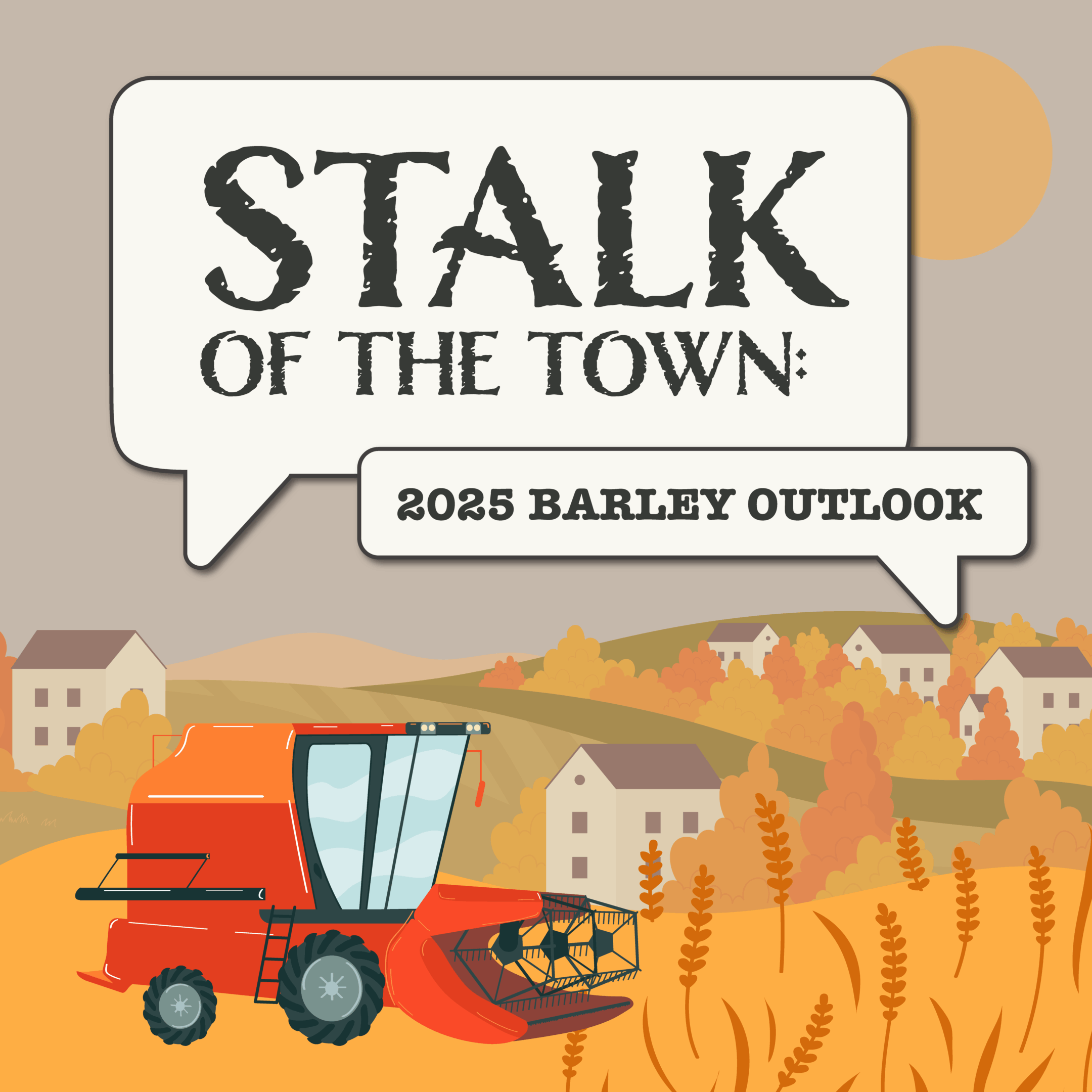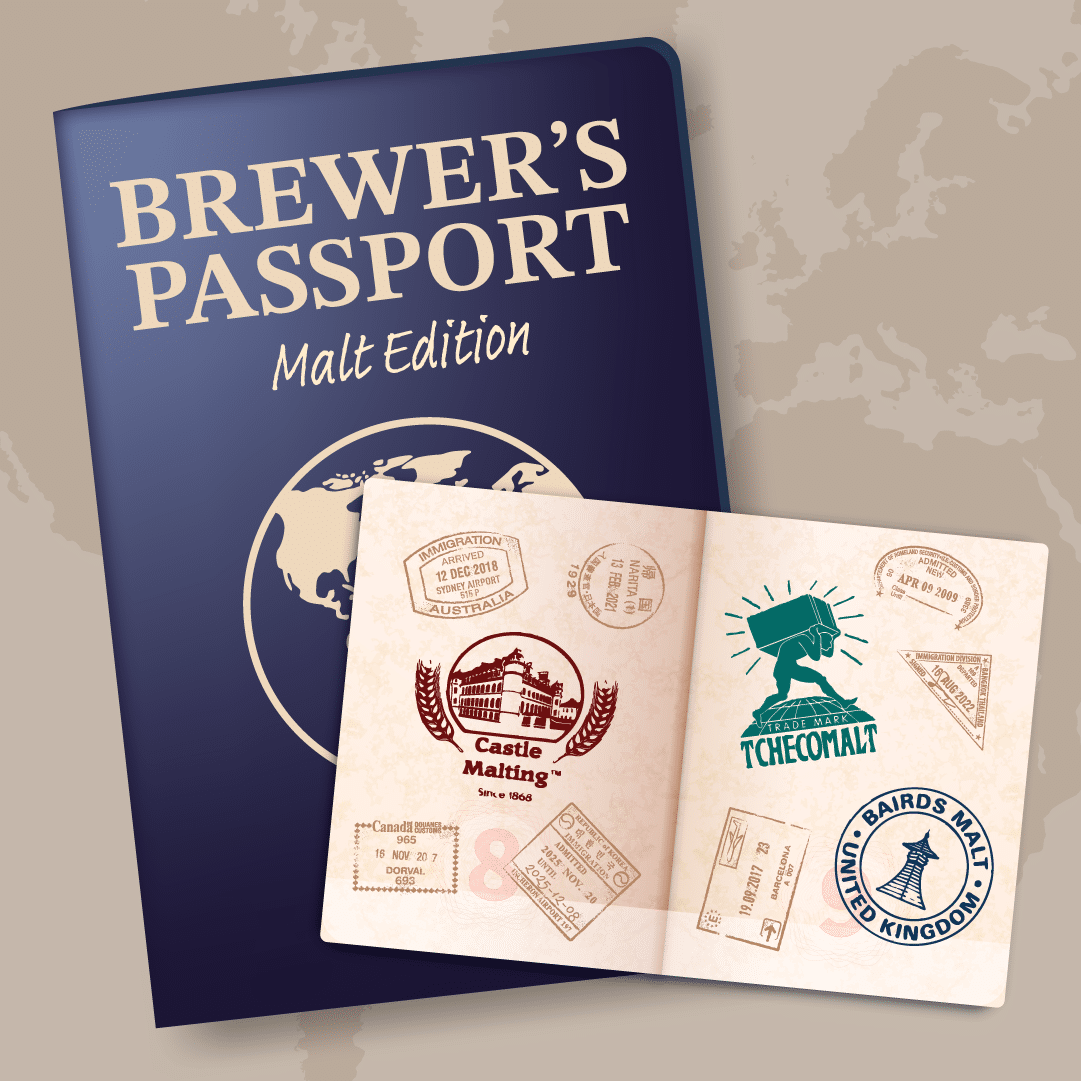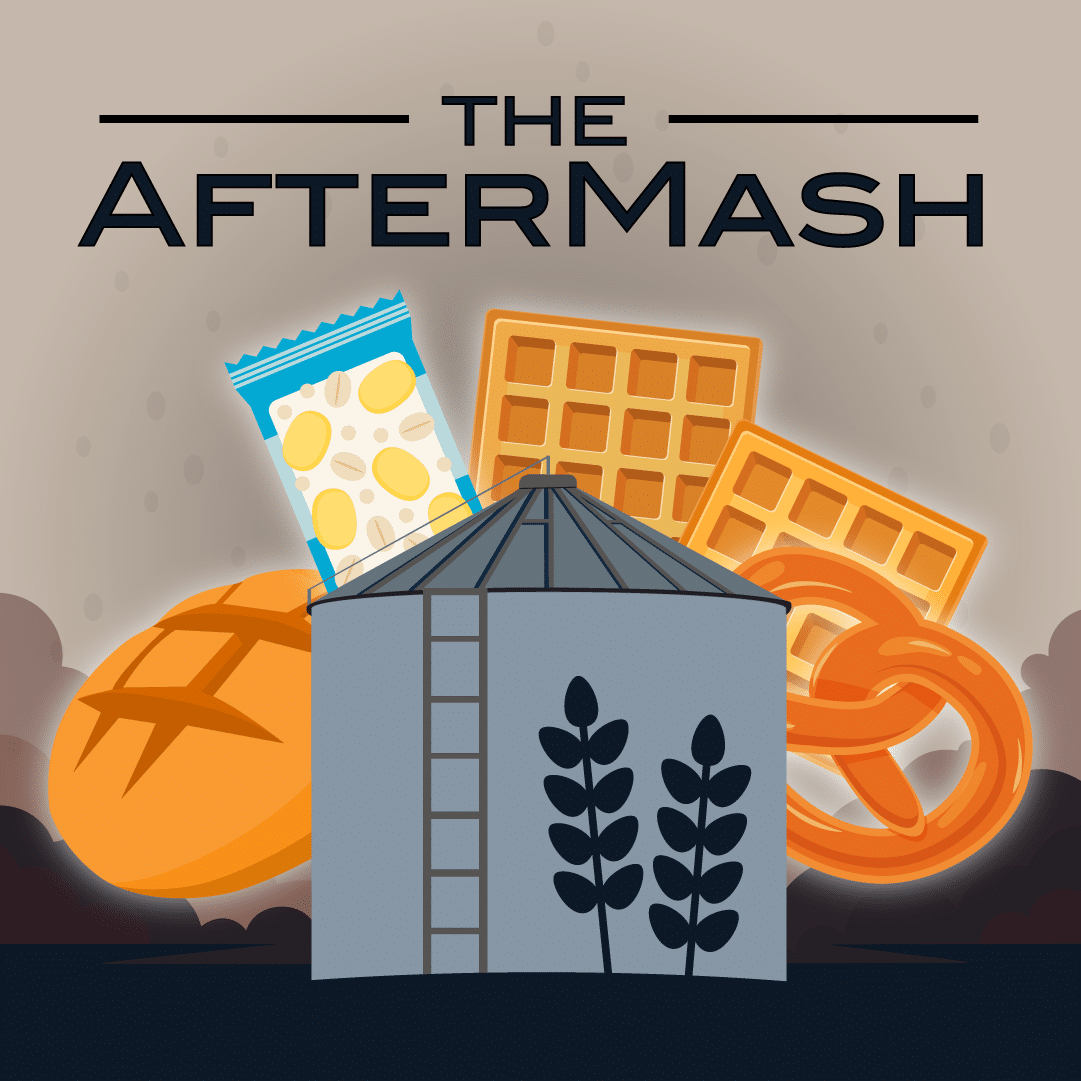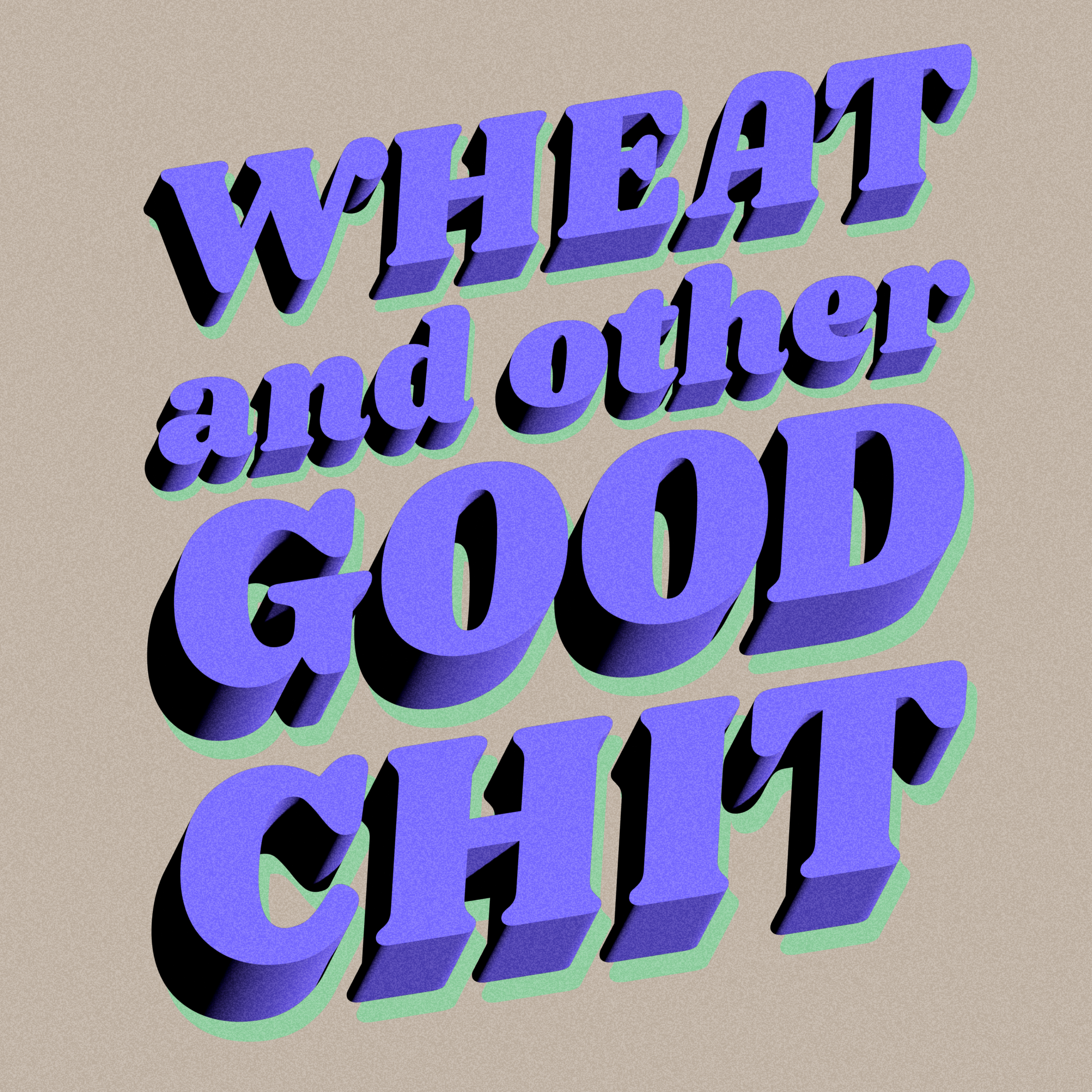
MORE EPISODES
SEASON 5, EPISODE 17: CERTIFIED WHEAT, SEVEN DAYS A WEEK
PODCAST HOSTS:
TOBY TUCKER – DIRECTOR OF SALES, COUNTRY MALT GROUP
HEATHER JERRED – TERRITORY MANAGER, COUNTRY MALT GROUP
GUESTS:
PATRICK SYLVESTER – TERRITORY MANAGER, COUNTRY MALT GROUP
ABI CONNER – PRODUCT MANAGER, COUNTRY MALT GROUP
Key Points From This Episode:
- The challenges of working with wheat in the malt house.
- The global production of wheat vs. barley.
- The use of wheat in hazy beers and the considerations for brewers.
- The flavor differences between red and white wheat.
- The use of flaked and torrefied wheat in brewing.
- Their favorite wheat beers.
Transcript - Certified Wheat, Seven Days a Week
EPISODE S.5, E.17
[CERTIFIED WHEAT, SEVEN DAYS A WEEK]
Toby (00:09):
What’s up, Heather?
Heather (00:12):
Hi. Hi, Toby. How are you?
Toby (00:14):
I’m pretty good. It’s good to chat with you again.
Heather (00:17):
Yeah. I feel like it’s been a while.
Toby (00:18):
Do you hear Big City Greens in the background? Have you ever heard of Big City Greens?
Heather (00:25):
No.
Toby (00:25):
My six-year-old has strep throat and so she’s home today, and I’m sitting here in the kitchen while she’s watching Big City Greens. It’s an kids’ animation show.
Heather (00:36):
Okay. Well, I don’t have kids.
Toby (00:37):
I don’t know. It’s an interesting show, but every time I go to sleep I have the Big City Greens theme song stuck in my head. It’s awful.
Heather (00:45):
Nice. The joy.
Toby (00:46):
It keeps the kids occupied.
Heather (00:48):
Joy of parenting. I think the only kids show that I know about is Bluey.
Toby (00:53):
That’s a good one.
Heather (00:54):
Well, it’s because I have a blue healer, so I have kids come up to me all the time and they’re like, “She looks like Bluey.” She does look like Bluey.
Toby (01:03):
That’s one of those really meaningful shows. It’s good for adults, too, because there’s actually a meaning behind each of the episodes, which is cool. My kids got into that and they graduated to Big City Greens. Well, all good. Well, enough of us bantering. We’re talking about wheat today.
Heather (01:20):
We are talking about wheat today?
Toby (01:23):
Which I don’t think in the five years that we’ve been doing this podcast, we’ve had a specific wheat episode, right?
Heather (01:30):
No. I know we’ve done rye, because we just did rye, so I could remember that. We’ve touched on a lot of our base malts and stuff, but no, we haven’t specifically talked about our wheat products.
Toby (01:44):
Which is pretty cool. You think, at least in the breweries I go to, the customer base that we have, it seems like everybody uses a touch of wheat in some form or fashion, whether it’s a wheat beer style specifically or just as an additive in some of their lineup.
(02:03)
But if you think about it at least on, and I’m talking about our side of production, so North American brands. Between Canada Malting and Great Western Malting, I think we do about 24,000 metric ton of wheat malt a year out of a capacity of, what do we do combined, 765,000 metric ton between those plants.
Heather (02:37):
The two. Yeah.
Toby (02:37):
It’s 3%.
Heather (02:37):
You’re just talking wheat malt, right?
Toby (02:37):
Right. Just wheat malt.
Heather (02:37):
You’re not even talking our flaked wheat.
Toby (02:38):
Or unmalted wheat.
Heather (02:42):
Or unmalted wheat. Yeah.
Toby (02:43):
It’s a pretty small percentage. I know when we talked to Patrick, who you’ll hear from later on in the show, but wheat is not a huge part compared to the overall wheat market in the world in the brewing industry. It’s tiny.
Heather (03:01):
It’s very tiny.
Toby (03:03):
Most of it goes into food. I don’t know. It’s an interesting subject. I think it’s an unsung hero or one of those that oftentimes this particular grain gets overlooked in the brewing and distilling world.
Heather (03:21):
Well, I think it’s in a lot more things than people know about, too. You’ve got a lot of wheat sprinkled into a lot of those IPAs that you’re drinking. That high protein content is what makes it look nice and hazy, and I think everybody knows about that.
Toby (03:36):
That’s right. Well, there are some challenges overall with working with wheat in the malt house. Wheat, as we know, doesn’t have a husk. It’s high protein, a lot of gluten is in there, and it makes for an interesting and challenging grain to work with in the malt house.
(04:01)
It absorbs water faster during steeping than barley. I think the lack of husk also causes the kernels to be more closely packed together, which could result in more germination heat to be generated and retained during germination, which could throw a lot of those temperatures off. There are some challenges working with it.
Heather (04:27):
Yeah. For sure.
Toby (04:28):
Obviously, I’m not a brewer by trade, but we do know that you get to a point where you’re brewing with too much wheat, you’ve got to have some way that you can lauter that stuff.
Heather (04:39):
Throw in a lot of rice hulls.
Toby (04:41):
That’s it. Yeah. The other thing I didn’t know until prepping for this, Heather, and you may know, but that spelt is actually a cross of wheat and wild grasses. Didn’t know that.
Heather (04:57):
I didn’t know that.
Toby (04:58):
See, this is how we learn. things.
Heather (05:00):
This makes me feel so much smarter. I grew up in a very heavy wheat growing area of Canada as well, and I couldn’t have told you anything about wheat back then. Shout out to Saskatchewan if anybody is listening in Saskatchewan.
Toby (05:21):
Well, I think at the very least you and I would be able to go out and say, “Hey, that’s a barley plant and that’s a wheat plant.” I feel comfortable with that.
Heather (05:29):
I feel pretty comfortable with that. Yeah. I feel like I could do that. I remember I learned imposter grains. Imposter grains.
Toby (05:38):
What are those?
Heather (05:39):
It’s basically when you get seeding from, it was imposter wheat. You get wheat seeds in with your barley seeds and they get planted. You can see little stalks of wheat sometimes showing up in your barley fields.
Toby (05:51):
Interesting.
Heather (05:51):
It’s kind of cool. Not cool, because you really don’t want wheat in your barley, but it happens. We’re going to talk wheat beer. What is your favorite wheat beer if you had to pick one?
Toby (06:08):
Let me get back to you on that one, because honestly, as we mentioned, there’s a lot of beers out there that use wheat, whether it’s in IPAs or it’s straight wheat beer. That’s a good one. Good question.
Heather (06:22):
Thank you.
Toby (06:22):
I’ll get back with you. You have one top of mind?
Heather (06:26):
I do. It was funny, because if anybody is listening remembers Adam Wilson. He used to host a podcast. I think he still works here. I don’t know. Do you still talk to him?
Toby (06:33):
He’s still around. He’s poking around somewhere.
Heather (06:35):
I hope he listens to this. He’s still around. One of the first episodes that Adam was on, we were talking about the ultimate summer beer, and he picked DeWitt, and he had reached out to me and he was like, “Hey, what wits are in your territory that you really love?”
(06:49)
I was like, “Oh, Driftwood.” Driftwood has this wit that is just amazing. He was like, “That’s all I want to drink now,” because he used to live out here and he used to get it all the time. Shout out to Driftwood and their wits. One of my favorite summer beers.
Toby (07:04):
There you go. Nice. I wouldn’t say it’s my favorite, but it is one at least down here where we are that’s pretty recognizable is Blue Moon.
Heather (07:13):
Oh, yeah. I actually had a Blue Moon last weekend.
Toby (07:18):
Well, I did, too. I did, too. That’s the first thing that came to my mind. We’re out at the lake and it’s a nice refreshing beer.
Heather (07:23):
[inaudible 00:07:23] a guy that I was out at my friend’s cabin and we had to run into a small town that’s near there to pick up a few extra groceries, and we’re like, “Oh, small town bar. Obviously, we’re going to stop into this small town bar.” Of course, they don’t really have much of a craft list for us there, so it was Blue Moons all around and they were delicious.
Toby (07:39):
Oh, yeah. I think 3 Floyds makes a pretty solid few beers with some wheat. What’s another? Allagash is another one.
Heather (07:53):
Good one. Yeah. Alla. I’m going to shout out Fahr Brewing in Alberta. They’re out in Turner Valley in Alberta, and Jochen is from Germany and completely makes these amazing German beers, and their Hefeweizen has won at the World Beer Cup before. It is absolutely delicious, so I’m going to shout out that one if you’re ever in Alberta and you can get your hands on it. It’s a good one.
Toby (08:17):
There you go. Nice. I’m going back to putting wheat in perspective here. There’s 700 million metric ton of wheat grown in the world per year. 5.6 million metric ton of barley is used in the US brewing market only, so think about the differences in wheat production versus barley.
Heather (08:45):
I believe the US is two or three in the world for wheat production.
Toby (08:51):
Yeah. I don’t know the stats, but I do know 20% of which is grown in the EU. I don’t know about the US though.
Heather (09:00):
Yeah. I believe it’s second or third. I know Canada is fifth in production of wheat in the world, so we got a lot of it over here.
Toby (09:10):
We do and we like brewing with it or distilling with it. We’re happy to have a couple guests on that know much more than you and I, I would say, about all things brewing products. Pretty much they’re better than we are all around.
Heather (09:28):
It’s fine. You know what? I’m going to give it to them. They’re better than us.
Toby (09:32):
That’s right. But you know what? We have a good time.
Heather (09:33):
Yeah. It’s true.
Toby (09:34):
Let’s get started if you want to, Heather. You want to get rolling here? We got Patrick Sylvester and Abi Conner going to join us. It’s a jam packed episode here.
Heather (09:43):
It’s a wheat packed episode.
Toby (09:45):
There you go. Wheat packed. Hopefully everybody enjoys it.
Heather (09:48):
Yeah. Let’s dive in.
Toby (09:49):
Let’s do it. Welcome to another awesome show we got going on here. We’re doing something a little bit different today. Well, our guests are not different. I think Patrick has been on several times, and then Abi Conner, who joins us probably every other episode. We’ve asked her to come in kind of round table style to talk about wheat. I guess it’s kind listen to Abi, and then we’ll do the ask Abi at the end, right?
Abi (10:20):
Sounds good.
Toby (10:21):
Yeah. We needed all the help we could get on this wheat episode, so I brought in the big guns. Patrick Sylvester, one of our TMs out in the, I just generally tend to say Northeast, but I don’t even know what the hell I’m talking about when I say that.
Patrick (10:34):
Yeah. You’re pretty close. I’m covering New England, Connecticut, Vermont, all the way up to Maine. Not a bad territory to have, especially for the wheat guys.
Toby (10:45):
Not at all. Abi, as the listeners probably know or may not know, she pretty much does everything. I don’t even know how you have time to sleep.
Abi (10:55):
Yeah. I don’t either. I actually don’t sleep. I’m a robot.
Toby (10:59):
It sounds like it. But no, Abi is 100% responsible for a lot of our new products, what we’re carrying, why we’re carrying it, educating our sales team and our customer base, and then also joining us on the show. Appreciate y’all jumping in.
Abi (11:16):
Thank you.
Toby (11:17):
Let’s talk wheat. What the hell is wheat with a W-H? Just to preface this, I did ask my son on the way home from a school orientation today what wheat was. He had to think about it. He’s like, “Isn’t it in bread?” That’s about the only thing he knew.
Patrick (11:38):
That’s pretty much it. He nailed it.
Toby (11:41):
Yeah. Then I mentioned beer and he didn’t know what I was talking about. He knows I work in beer, but that’s about it.
Patrick (11:47):
One day.
Toby (11:48):
Let’s keep it that way.
Patrick (11:48):
One day.
Toby (11:49):
Cool. All right. The general question is what is wheat?d we talk about barley all the time, but this one is going to be dedicated to wheat. Who’s got the answer?
Patrick (11:59):
I think I’ll take a stab at it and give a little explanation. In my eyes, wheat is a cereal grain. It’s a little bit higher protein. That’s the big draw of value to brewers. We’re seeing it a lot with these hazy beers or maybe your Hefeweizens or something that you want a little bit more mouthfeel to.
(12:18)
We’re going to lean on wheat for that. It’s just got a couple more percentages of protein in comparison to barley, a little bit of a softer flavor, and a little bit of a slight acidity, which I kind of like about wheat beers. It’s a lot of fun to play with.
(12:36)
It’s pretty widely grown. It’s a pretty large agricultural product. We’re actually not the top purchaser of wheat, so the baking industry kind of takes command on that one, but you get in a ton of different formats that makes it fun for us to use in the brew house.
Toby (12:53):
Absolutely. Well, you mentioned hazies. Is Wheat one of the dominant adjuncts used in hazy or there’s a lot of different ones for brewers and customers to [inaudible 00:13:05]-
Patrick (13:04):
There’s a couple ways to skin that cat, but we see a lot of guys using it as one of the main players to accomplish that haze. Now, what product they use, we can kind of talk about that a little bit later, but wheat is definitely a foolproof way to get at least some sort of established haze in your beer, which is great. That’s what everybody wants, and really it’s a stable haze, and that’s the biggest takeaway from wheat.
Toby (13:31):
Oh, great. Well, I’ve never been to your house, Patrick. Correct me if I’m wrong, I don’t think you have tilled acreage in your backyard or anything.
Patrick (13:39):
No. A couple of square feet.
Toby (13:42):
There you go. Well, what about, and again if you’re not familiar, don’t know the answer to this, but just curious, growing regions of wheat. Is it different than where you find barley typically grown?
Patrick (13:55):
There’s a lot of crossover to barley, but I would say that wheat is actually grown more globally than barley. It’s a little bit more of a widespread. I actually drew these numbers up not so long ago. The wheat industry is about five times the size of barley, just to give you an idea of agricultural global impact.
(14:17)
United States is, I think, number four in terms of producers of it, and Canada is a little bit behind that, so probably about number six. It’s actually grown a lot in China, Russia, and India, I believe, are leading on exports for that. It’s definitely a global product for sure, so a lot of variation depending on the regions and whatnot.
Toby (14:40):
Yeah. Cool. Going back to on the brewing side, I know Abi has a brewing background as well, so maybe a question for both of y’all. But what kind of considerations would you say if a brewer is interested in including wheat and doing a hazy or another product as well? Is there a typical inclusion or does this depend on what kind of beer they’re brewing?
Abi (15:07):
I think it just depends on the beer that they’re brewing, but also what kind of wheat? Are you using it as an adjunct or a malt, unmalted? I typically would use anywhere up to 40%, but you want to use it with a base malt, because especially with an unmalted, because you want to be able to make sure that the sugars can actually ferment. Patrick, you might have a better answer than me, but that’s typically what I would have used.
Patrick (15:33):
Yeah. Again, there’s so many different products within the realm of wheat, so it depends on really what you’re talking about. With wheat malt, you can actually, I’ve seen guys be crazy enough to go 100% wheat, so it really can have a wide scope in terms of your grist.
(15:52)
It should be noted and taken into account, and I can attest for this multiple times, wheat is huskless, so you have to account for that when you’re thinking about your laudability, stuck mashes, things like that. You can’t just go throwing a ton in without compensating with rice hulls or some other better filtering agents to it.
(16:12)
I think Abi is kind of spot on there. I’d like to play conservative around that 40% to 50% inclusion on something like wheat malt. I think that gets the point across. If you’re using unmalted wheat, it’s a little bit of a gnarlier product to use.
(16:27)
There’s a little bit of a more careful approach in the mash ton. I probably wouldn’t go anywhere near 15% to 20% of that. It’s a gummy product for sure, so you’re likely to gum up your mash tun grates, and not a good day for that.
Toby (16:48):
Yeah. I imagine. All right. You just mentioned a little bit about malted versus unmalted. It’s pretty straightforward. Unmalted does not make it into the malt house and it’s not malted, but anything to expand there?
Patrick (17:02):
I can definitely add, there’s one really interesting thing, and I think it’s helpful for a lot of brewers to think about it in this way. On the unmalted side you have unmalted wheat. Technically torrefied isn’t really malted nor flaked, and what those products offer is a long chain of protein.
(17:22)
Again, we talk about that protein content that comes with wheat. It has these long heavy chains of protein in there that give you that really nice thick turbidity that a lot of guys are looking for. Now, when you compare an unmalted versus malted, sometimes those long protein chains, they’re heavy. They’re heavy in suspension.
(17:43)
What you see a lot when you’re using a lot of unmalted wheat is that it’s not a very stable haze. You might start to see some dropout maybe a couple weeks [inaudible 00:17:53] month or two months into the storage of that product, and you might want to rouse the keg or get that back up.
(17:59)
In comparison, malted wheat, so wheat malt, it takes that same level of proteins, but the malting process kind of beats them up a little bit and makes them into smaller chains. A result of that is actually a more stable, but less intense haze, which I think is actually kind of neat, because we’re seeing a lot of guys struggle with haze stability out in the market right now, and somehow just pivoting a portion of their grain belt over to that wheat malt allows for a little bit of a safety net.
(18:31)
You know what I mean? A little bit of a nice haze that’s perpetual, stays in suspension, and then you can really beef it up for those earlier months. If you know your product is going to move in the next couple of weeks, well, you can get that nice turbidity through the unmalted wheat selection to it. You can kind of have a mix and match of both in my eyes.
Toby (18:48):
Yeah. No. That’s great info for the listeners. If somebody were using, let’s say 40% unmalted wheat and, using your suggestions, wanted to come in and integrate some of the malted side. Are you saying do a 20/20 split of that 40, or is there people using both?
Patrick (19:10):
Yeah. You would do a dual-headed approach on it, again, because you just want a safety net to be there when your heavier turbidity falls out. You still want haze there. You don’t want that clarity to kind of just show up one day and then you’ve got a problem. If you’re doing 50% of your grist is going to be a wheat product, I would recommend a 25%/75% split between unmalted and malted wheat or something along those lines.
Toby (19:41):
Great. This one is an interesting one and I think in the last five years at some point we had an episode around adjuncts, and specifically the argument of red wheat versus white wheat. Back in the days when I was actually productively selling in market and not behind a desk, I got this a lot, which is I really like the flavor of red wheat. In your experience, do you notice a flavor or difference between red and white wheat? Honestly, it looks similar, right?
Abi (20:19):
Yeah. We have both and the colors are about the same. You’ve got anywhere between 1.7 and 3.5 SRM, but I do think the flavor is a little bit different. I get a little bit more of a biscuity, a sweetness in it with the red. I don’t know. Patrick, what do you-
Patrick (20:41):
Yeah. Same thing. I’d say the same. A lot of guys, it’s funny with the red versus wheat commentate, because when that conversation comes up, a lot of people are like, “Oh, I like to keep my beers nice and light. I want to use white wheat.” Well, the color is kind of negligible.
(20:56)
They’re pretty much the same. We can really make it in both the same spec to kind of hit those color targets. But for red wheat it’s got a little bit slightly of a higher protein content, and then in result of that it has a more, I guess, the best word would be a robust flavor. It’s a little bit more beefy, a little bit more flavorful than your typical white.
(21:19)
If you’re looking for a mouthfeel, but a neutral base, I’d lean towards white. If you’re looking for that same mouthfeel, but you want to have some character kind of develop behind it, I trend towards the red wheat on that one. Actually, I will say that I’ve seen more and more brewers experiment with red wheat and like the results.
(21:39)
I’m getting a lot of guys that are transferring over. We have a couple of big red wheat purveyors out here that they use it in their IPAs, and they like the way that it complements everything else that they got going on in that grist.
Toby (21:51):
Interesting. Going back to your comment about a slight bit of acidity, any difference between the two?
Patrick (21:59):
Not that I’ve noticed, except for the fact that because the red wheat is a little bit more robust in flavor, you’re probably masking that tartness that naturally comes with wheat in general. But it’s nothing that would alter the way that I handle a wheat product in my grist or anything like that. It’s just an added benefit.
Toby (22:21):
Right. That’s good info. What about, we talked a little bit about different variations of wheat. Flaked wheat, torrefied wheat. What about those types of products versus wheat malt? When and why would a brewer or distiller be using the flaked product or torrefied or whatever forms of the adjunct?
Patrick (22:47):
I can take this one. I think the best way to explain the different variations here is to start from the beginning. You would use unmalted wheat if you want the raw flavor to kind of come through and neutral, but still kind of a grainy texture that is going to come through with that wheat malt.
(23:08)
The downside of unmalted wheat is that it’s very finicky, so you really got to crush that thing. You really got to get it right to get any sort of expected extract out of it the same way that you would get out of a normal malt, and it takes a lot of effort to really get that dialed in.
(23:27)
Now, torrefied wheat. Torrefied wheat is probably the most mysterious out of all of them. A lot of guys don’t even know what the torrefication process is, but essentially what it is that the raw wheat is passed through a bit of hot air similar to making popcorn, and what that’s going to do is it’s going to burst the outer cell walls inside of that kernel and make those interior starches a little bit more easily accessible.
(23:53)
It’s a little bit more consistent than just using unmalted wheat. It’s a little bit more controllable, but it is going to have a slightly more biscuity taste, just because of that application of heat that goes through it. Now, with that, you still have to handle it with a little bit of care.
(24:10)
Wheat is a little difficult to mill. It’s a different kernel size, different kernel hardness. If you want to take the guessing game out of it, well, that’s where flaked wheat comes in. Flaked wheat essentially is torrefied wheat that’s just gone through the flaking facility or through the flaking process, I should say, and now you don’t have to mill that.
(24:30)
You can add it right into the mash tun and you know you’re going to get that expected extract that you were banking on. It’s a little bit more of a user friendly, little bit more costly. But honestly, the difference in cost of goods between torrefied and flaked are somewhat negligible to the impact it has in the brewhouse and whatnot.
Toby (24:50):
Makes a lot of sense. We’ve got a lot of really great wheat products. And Abi, I’m glad you’re here, because our portfolio is massive. We come out with new stuff every month or so. Hell, I can’t even keep up half the time. What do we have, 30?
Abi (25:07):
30. Yeah.
Toby (25:10):
30 wheat products. Jesus.
Abi (25:11):
Yep.
Patrick (25:12):
My God.
Toby (25:13):
I’m going to quiz you right now, go through every one of them. Ready. Go. I’m just kidding.
Abi (25:18):
It’s so funny, because we have around 1,000 SKUs in our portfolio. We’re just constantly trying to evolve it to make sure we have everything that our brewers and distillers need to make great beverages. But I was looking at our products trying to come up with my favorite ones, wheat products, and there were 30, and I know that I’m adding a few more in the next year or two.
(25:39)
It’s just constantly evolving, and like we talked about, there’s a lot of different types of wheat products. We’ve got a lot of different variations that you can use at different volumes for different results, but I’m just going to go over a few of my favorites, because otherwise we will be here all day long.
(26:00)
I don’t know if you want to hear me talk for that long, but we talked about lighter color wheats that we have. We talked about reds and whites. We’ve got a white wheat from GWM and another one from Briess. You’re going to find a lighter finished color with those, which is kind of a more popular thing to do right now is to have those lighter beers.
(26:22)
You’re going to find that finished color with Briess’ white wheat at about around two and a half or so, and then with GWM’s you’re going to be sitting at around three to 4.5. You can still have those wheat characteristics, that head retention and stability with that really light color. That’s really nice.
(26:45)
We’ve got one from Canada Malting. That’s that red wheat. Again, the color is the same. You’d think with the name red, it would be darker. It’s not, but like we did talk about, it has that more robust flavor for you at an SRM around 2.5 to 3.5. All three are really great for making any kind of a wheat beer, just depending on how much you want to use, and just again, great for that head retention and body.
(27:15)
Great Western has an unmalted wheat. We talked about that a little bit. It’s really nice for those Belgian beers or any beers that you want to add some good head to. Like we said earlier, the product doesn’t really undergo that germination or kilning, so it has that higher beta-glucans.
(27:32)
If you want to go all out, you can try out Briess’ torrefied wheat. It’s really fun to use for that stealthy mouthfeel and a clean wheat flavor as well. We do have a new adjunct facility at Canada Malting in Calgary. They do make a stellar flaked wheat that’s a lot of fun to use. It’s super easy to use, around 40%, super efficient filtering, and it has that really nice creamy sweetness to it. And then we can go with a darker SRM.
(28:04)
We’ve got a really cool one from Briess. They’re really known for their roasting. They know what they’re doing as far as the roasting facility goes, and they have the Midnight Wheat. This stuff is dark. It’s at 550 SRM. A little goes a long way, but it really delivers that wheat characteristic and then having that really lovely creaminess to it without having that super stark roasted flavor. Really fun to use that one as well.
(28:35)
Like I said, I could keep going on and on and on about this, because we have so many products that we could talk about. We’re constantly trying to add new things for you to try as well as having all of the different products that you know and love. If you want to check out all of our products, head to our website. Just search wheat and you’ll see the extensive list that we have, and if you see something that you would like to try that’s not on there, just give us a shout.
Toby (29:04):
Sounds great. Going back to the CMC flaked wheat coming out of the flaking facility, those are beautiful. I saw them the first, I guess, couple goes. The flakes look huge and it looked fake.
Abi (29:20):
Right. Yeah. They’re gorgeous.
Patrick (29:23):
It feels weird to geek out about the size of flakes, but same thing. When I got them in hand, I was like, “These are gorgeous.” My partner thought I was crazy.
Abi (29:32):
Yeah. No. I have them on my desk and I actually admire them sometimes. Being a product manager and seeing all of these different flakes and all the different types out there, it’s just really, really fun to see a really good quality flake. Nice, big and beefy. It’s awesome.
Patrick (29:50):
I was just going to say, just one more thing on that is that we talk about wheat not really being grown for brewers, so it’s always great to get it in the hands of somebody like Canada Malting, who’s going to take it to the next level for us and make sure that that quality is top-notch every single time.
Abi (30:06):
Definitely.
Patrick (30:06):
[inaudible 00:30:07]-
Toby (30:08):
Yeah. That facility is state of the art. I’m super curious and excited about what they continue to come up with out there. I think they’re slowly integrating some new products and utilizing that facility for other future products, so exciting stuff.
Patrick (30:25):
Can’t wait.
Toby (30:26):
Yeah. Absolutely. All right. Tell me about some of your favorite beers using wheat.
Abi (30:36):
Wheat.
Patrick (30:36):
I’ll go first. I got two big breweries out here. I have Lord Hobo and Lone Pine. They’re making top quality IPAs. Both of them are leaning on that red wheat pretty hard for it, so they’re great to grab during the summer, especially as we transition the fall. A little bit of an added flavor to it from that red wheat, but they’re unique and standalone on their own, so they’re both awesome products.
Toby (31:03):
Cool. What about you, Abi?
Abi (31:04):
I feel like I’m put on the spot.
Toby (31:10):
Anything that has wheat in it, I’ll drink it.
Patrick (31:12):
I think we also got to give nod to Frances Conner. Don’t forget about the old dogs. [inaudible 00:31:19]-
Abi (31:19):
That’s very true. Very true. Very true.
Patrick (31:22):
Except I’ll have one of those beers and then I’ll be done for the night. That’s enough. They’re so filling. [inaudible 00:31:31]-
Abi (31:31):
I’m just one of those people that if you ask me for a name, my whole brain just freezes and I have no idea.
Toby (31:38):
It’s okay. It’s all right. I’m looking at a list of about 30 breweries out there that have won a medal with wheat, and I’m not going to read through all of them, but there’s a bunch of good ones in there. Icicle Brewing has won a couple. Comrade Brewing, 10 Barrel Fieldhouse, PoCo Brothers, Fat Head’s, Phillips Brewing, Taproom Beer. A lot of good ones in here.
(32:10)
It’s interesting. I think what listeners may not know, just a general consumer probably doesn’t realize there’s a lot of beers that they wouldn’t assume there’s wheat in it. Either in a very small portion, just as Abi mentioned for head retention and other reasons, but wheat goes into a lot of different beers for sure.
Patrick (32:31):
Right. It’s sort of an unsung hero. It can be neutral, it can be in that background, but if you don’t have it, you’re missing something on that beer. It helps you get that full body picture to it, which is great.
Toby (32:45):
Yeah. Absolutely. Well, hey, I appreciate y’all’s time. It’s always awesome to have you on, Patrick, and Abi, you as well. I appreciate the insights on the wheat and I look forward to chatting with y’all next time. As Abi mentioned, we’ve got just a bunch of different awesome wheat products. Reach out to us. Reach out to your territory manager, salesperson. Just reach out. We’ll help you out and point you in the right direction. Appreciate everybody and thanks for joining, y’all.
Patrick (33:11):
Awesome. [inaudible 00:33:12]-
Abi (33:11):
Thank you.
Toby (33:12):
Talk soon. Well, that was a lot of fun. Thanks so much to Patrick Sylvester and Abi Connor, who have joined us other times on the show. It’s always great having them back. As a reminder, pre-orders are open for the seventh annual Veterans Hot Blend from Yakima Chief until August 26th.
(33:31)
I believe it’s a blend of Citra, Crystal, Ekuanot, El Dorado, and Simcoe. What you’re going to get out of is some very citrus and stone route forward, and I think it’s 12.5% alpha acid. When you do purchase this year’s Veterans Blend, CMG donates three bucks per pound to Stop Soldier Suicide, which is the only national nonprofit organization dedicated solely to reducing the suicide rate among our nation’s veterans.
(34:01)
Join us in supporting Stop Soldier Suicide to further the mission of assisting US veterans in creating a future where veterans and service members are at no greater risk for suicide than any other American. It’s a great cause. If you’re interested in learning more, reach out to your CMG rep and we’ll be happy to put you in touch and give you some more information on that.
Heather (34:22):
Amazing. Just a reminder, we talked about this a couple episodes ago, and as we spent a lot of time today talking about planting and farmer’s fields and all that fun stuff. We recently launched our rain to glass posters, which is a collection of high resolution printable posters for Great Western Malting and Canada Malting. If you’re interested, head over to CountryMalt.com/posters and you can learn more about it.
Toby (34:53):
There you go. I’m excited that we’re going to be back in a couple of weeks with another fun-filled episode, and grab your homing pigeons, throw them up in the air, and go get them to subscribe.
Heather (35:03):
Great way to put it.
Toby (35:04):
There you go.
Heather (35:05):
[inaudible 00:35:06]-
Toby (35:06):
All right, Heather. We’ll talk to you soon.
Heather (35:07):
Bye.
Toby (35:08):
Bye.









